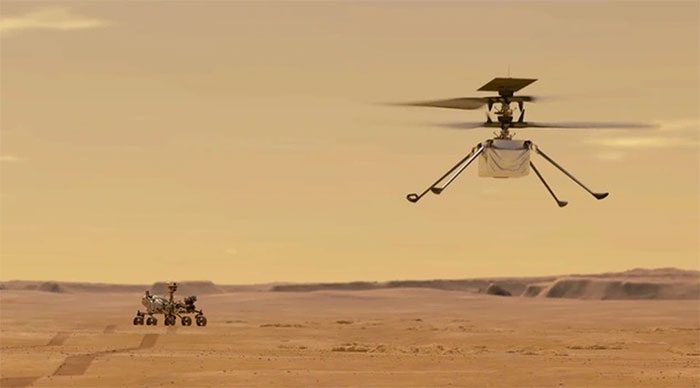NASA is funding a project to develop a uniquely designed aircraft capable of flying on Mars to search for signs of life on the “Red Planet.”
The United States National Aeronautics and Space Administration (NASA) has invested in a 9-month research project to develop an aircraft that can fly on Mars for in-depth studies of the planet.
The aircraft, named MAGGIE (short for “Mars Aerial and Ground Intelligent Explorer”), is designed for vertical takeoff and landing.
The plane features long wings with the upper surface covered by solar panels, allowing it to travel a distance of 179 km on a full charge.

The special design concept of MAGGIE, the aircraft used to search for life on Mars. (Photo: Ghe-Cheng Zha).
MAGGIE will be designed to operate flexibly in the thin atmosphere of Mars, under various weather conditions, including the harsh winter on the planet.
Typically, atmospheric pressure on Mars ranges from 6 to 10 millibars, which is only 1% of the pressure at Earth’s surface. The average temperature on Mars is -60 degrees Celsius and can drop to -125 degrees Celsius during winter. At this time, the pressure on Mars significantly decreases, making it challenging for the aircraft to take flight.
MAGGIE is designed to operate continuously on Mars for 1 Martian year (equivalent to 1 Earth year and 320 days), and can fly anywhere on the Martian surface at a maximum altitude of 1,000 meters. It can also land on any surface on Mars to collect and analyze samples, then send data back to scientists on Earth.
One of MAGGIE’s primary missions is to search for methane on Mars. Methane is considered a sign of life, yet scientists have faced many challenges in detecting its presence in the Martian atmosphere over several decades.
The MAGGIE aircraft will be equipped with highly sensitive sensors and detectors to identify trace amounts of methane in Mars’ atmosphere or other potential phenomena on the “Red Planet”, such as water or liquid.
Methane, a gas that can be a biological marker for life, is notoriously difficult to detect on Mars. These gas molecules occasionally appear in the Martian atmosphere, but their concentrations change frequently, making it difficult for scientists to gather samples for analysis.
Currently, MAGGIE is being developed by Coflow Jet, a company specializing in jet technology and space technology. Before being sent to Mars, MAGGIE must undergo testing to ensure its capability to take off and maneuver in the thin Martian atmosphere.
If it fails to pass the tests, there is a possibility that MAGGIE may remain merely a prototype and will never be launched to Mars.
Prior to MAGGIE, NASA had also sent the Ingenuity drone helicopter, which weighs about 2 kg, to Mars to test the feasibility of flight in the Martian environment, which has different gravity and atmospheric conditions compared to Earth.

The Ingenuity helicopter made history with its flight on April 19, 2021. In the background is the Perseverance rover exploring Mars. (Photo: NASA).
On April 19, 2021, the Ingenuity helicopter completed its first flight on Mars, marking a historic milestone as the first human-designed object to take off on the “Red Planet.”
Ingenuity successfully completed 72 different flights on Mars before concluding its operations this past January. It accomplished its mission of proving that flying vehicles can take off on Mars to conduct planetary research missions.





















































